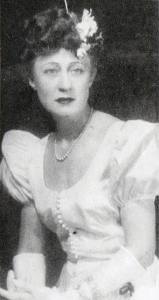
Yvonne Giguère Arcand to Adrien Arcand’s right (left on the photo). May 1938, at an assembly of the National Social Christian Party. Barely a month later it would become the National Unity Party of Canada. This woman has attitude.
|
Snapshots and impressions of the Feminine are found in Arcand’s writing, portraits of women are found in the cartoons of his Goglu humor review. In cartoons, we find the “pretty little French Canadian” at the mercy of unscrupulous shopkeepers. We find the Province of Quebec portrayed as a pretty young Suffragette with a bob, and the Constitution of Canada appears in a robe with a sash. Adrien Arcand was an artist. He painted portraits. I’m not sure which if any of the Goglu cartoons were his (some probably were), but he certainly published them all, and therefore his concept of the Feminine can be legitimately derived from what he wrote and what he published.
Arcand viewed Christianity as emancipating women, and he says that in gratitude, women responded by helping to build Christianity. Here is an excerpt from his public talk in 1954. |
“Is Christianity Bankrupt?”Le Christianisme a-t-il fait faillite? (1954) |
|
La même situation de “moralité” se retrouva, à un degré de vulgarité plus avilie, sous la grande époque classique romaine des Virgile, Tacite, Tite-Live, Pétrone, des césars Jules, Auguste, Tibère, du poète Horace qui écrivit toutes ses odes au lendemain d’orgies dans les lupanars, Cicéron, Marc-Antoine et leurs illustres contemporains. C’est pourquoi, lorsque le message de pureté et de renoncement du christianisme arriva dans la Grèce conquise et la latinité à son pinacle, ce fut dans les foules rongées par l’amertume du dégoût et de la honte comme une rosée rafraîchissante, un message de beauté, de consolation, de relèvement et d’espoir. Filles et femmes surtout, jusque-là simple bétail d’amusement, sentirent la vérité et la réalité de leur âme, la noblesse de leur nouvelle considération. Ce sont elles qui, par leur nombre et leur influence, par leur nouvel idéal et leurs sacrifices, firent la force naissante et finalement le triomphe du christianisme. Celui-ci en retour, exalta à un degré jamais connu la beauté de la jeunesse pure, la sublime grandeur de la maternité et émancipa la femme de juste émancipation à mesure que se développa le culte marial. La dignité que la femme a conquise en Occident, c’est au christianisme, et à lui seul, qu’elle le doit. |
“The same state of affairs with respect to ‘morality’ was found at a more degraded level of vulgarity in the great classical Roman period of Virgil, Tacitus, Livy, Petronius; the Caesars: Julius, Augustus, Tiberius; and the poet Horace who wrote all his odes in the aftermath of orgies in the lupanars; and Cicero, Marcus-Antonius and their illustrious contemporaries. That is why the message of Christianity — of purity and renouncement — arrived like a refreshing dew in conquered Greece and Latinity at their pinnacle:v a message of beauty, of consolation, renewal and hope. Above all, girls and women, till then mere animals for amusement, felt the truth and reality of their souls, the nobility of their new importance. It was they who, by their numbers and influence, through their new ideal and their sacrifices, produced the rising force and finally the triumph of Christianity. Which in return, to a degree never known, exalted the beauty of pure youth, the sublime grandeur of maternity and emancipated woman with a righteous emancipation as the Marian cult developed. The dignity conquered by Western woman is owed to Christianity, and to it alone.” |

